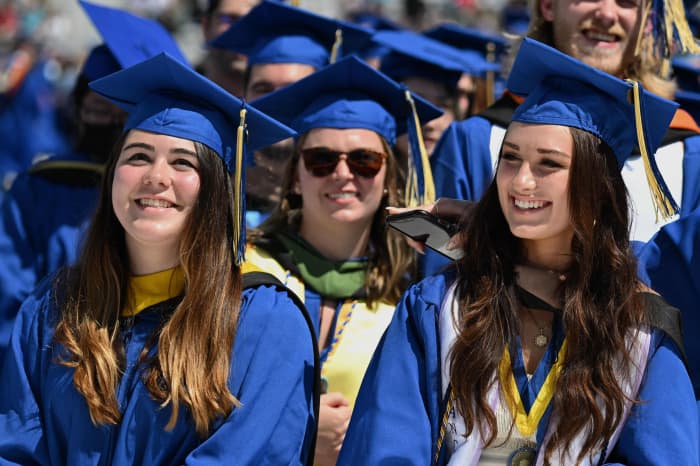[ad_1]
She doesn’t know how much her student-loan bill will be when the years-long pandemic-era freeze on payments ends. Eminger’s loans were transferred during the pandemic to a new servicer, but she’s struggled to communicate with the organization, which could help her learn her monthly payment amount. She’s also rushing to take steps that could provide her access to a loan-forgiveness program for public servants.
“I am very nervous about them starting again,” Eminger, 37, who has about $175,000 in student debt, said of the loan payments. “There’s just a lot of uncertainty and murkiness around it, which for a loan amount of my size is pretty scary.”
After a more than three year freeze, payments, collections and interest are scheduled to resume on federal student loans later this year. This is the ninth time — spanning two administrations — that the government has threatened to turn payments back on. Once again, borrowers, advocates and servicers are gearing up for a financial and operational headache.
“It’s going to be frustrating for everybody involved, borrowers, servicers, the Department of Education, advocacy organizations like ours,” said Betsy Mayotte, the president of the Institute of Student Loan Advisors, a nonprofit that helps borrowers manage their student loans.
To advocates who pushed officials to delay restarting payments in the past, this moment in many ways looks similar to the months before the freeze was scheduled to end eight other times. A challenging economy means borrowers’ budgets are still tight and promised fixes to the student-loan system that could help ensure a smooth transition to repayment and make borrowers’ bills more manageable still haven’t materialized.
But a few key factors are different, some of which are upping the pressure on the Biden administration to turn the student-loan system back on: The official end to the pandemic emergency, congressional Republicans taking aim at the payment pause in two pieces of legislation and multiple lawsuits challenging the freeze. Other elements unique to this moment are exacerbating the uncertainty and challenges related to restarting payments. Servicers will have fewer resources than in the past to handle a likely crush of calls.
“The Department remains focused on doing everything in its power to better serve students and borrowers, and we are fully committed to supporting student loan borrowers as they successfully navigate returning to repayment,” a Department of Education spokesperson wrote in an email. “The Department is deeply concerned about the lack of adequate annual funding made available to Federal Student Aid this year,” the spokesperson said, referring to Congress’s decision not to increase funding for FSA, despite the agency’s request. “As the Department has repeatedly made clear, restarting repayment requires significant resources to avoid unnecessary harm to borrowers.”
For Eminger, like some borrowers, part of the anxiety surrounding the restart to payments stems from major upheaval to the student-loan system that’s been announced during the pause that will make her loans more manageable. But accessing these benefits requires both diligence — staying on top of announcements and paperwork — and patience while she and others wait for officials to fully implement the initiatives.
“The rules have been changing so much,” she said. “Before the pandemic I felt like I very much understood what I was required to do. I always felt very on top of it. Now it just feels like a completely moving target.”

Kate Eminger said she’s nervous about student loan payments resuming.
Courtesy of Kate Eminger
Compounding her uncertainty is a lack of clarity surrounding exactly when payments will resume. In November, President Joe Biden told borrowers they can expect the pause to end some time in the late summer, but he didn’t give an exact date. In addition, it’s hard for Eminger to see how this deadline for payments to restart is different from all the others, where student loan bills never materialized. All of that has made it difficult for Eminger to figure out exactly when to take steps to make sure her student loan bill can fit in with the rest of her budget, like selling her car.
“It does not feel real at all,” she said of the restart of student loan payments. “It would be great to name a date. If they could name a date and if that date felt certain then you could plan.”
***
The Biden administration has said that the freeze will end 60 days after litigation surrounding its plan to cancel up to $20,000 in debt for a wide swath of borrowers is resolved or 60 days after June 30, 2023, whichever comes first.
“When payments turn back on it’s going to be a big problem,”said Eleni Schirmer, a researcher and organizer with the Debt Collective, a debtor activist group, “but to not even be granted the dignity of a clear date of when that happens just makes it even more of a problem.” She described providing a ballpark for the restart of payments instead of an exact date as signaling an “almost cruel indifference,” for how resuming student loan bills will impact borrowers.
That uncertainty could exacerbate the stress that student debt already places on borrowers, according to Daniel A. Collier, an assistant professor of higher education at the University of Memphis, who is studying the impact of student debt on mental health. What he’s found is that people who are the most uncertain about what’s going on with their student loan have the highest rates of psychological distress and suicidal ideation. For example, these borrowers worry they’re not getting an accurate sense of their balance or the number of payments they need to make before qualifying for a forgiveness plan.
“People are concerned about the pause because they don’t know what a restart looks like, this has never been done before,” he said. In the past, when payments have resumed after more limited pauses, delinquencies and defaults spiked — part of the Biden administration’s legal rationale for tying mass debt cancellation to the restart of payments. Borrowers don’t know “when it’s going to start, what their repayments are actually going to be,” Collier added.
Kevin Noonan, who together with his wife has about $100,000 in student debt, said he’s benefited from the pause. The couple has used the extra room in their budget to pay down private student loans. Still, Noonan is “frustrated” with the lack of clarity surrounding payments resuming and the status of the administration’s loan forgiveness plan.
“Not knowing is the hardest part,” he said. “I have a Google alert set up, every time student loans come up I check everything. You kind of just have to plan for the worst-case scenario.”

Megan and Kevin Noonan owe about $100,000 in student debt combined.
Courtesy of Kevin Noonan
The decision to tie the resumption of payments to the court’s decision “added an element of unpredictability,” said Persis Yu, managing counsel and deputy executive director at the Student Borrower Protection Center, an advocacy group.
“There’s the choice to not land on a certain date, but there’s also the choice of 60 days,” Yu said, referring to the 60-day delay in between the court’s decision and payments resuming.
“I really wonder whether or not 60 days is enough time for borrowers,” she said. “When we think about the amount of work that is really going to have to happen to effectively turn on this system, 60 days does not seem like a lot of lead time.”
Secretary of Education Miguel Cardona said in a Congressional hearing this month that the agency is “preparing to restart repayment because the emergency period is over.” He told another congressional panel that the agency is “geared up and ready to go,” to resume payments.
Scott Buchanan, the executive director of the Student Loan Servicing Alliance, a trade group, said that 60 days should be enough time for student-loan servicers to implement the restart to payment. In order to accomplish that, they’ll need to be able to communicate with borrowers in the coming weeks about the end of the payment pause and be allowed to offer flexibilities like forbearance and allowing borrowers to verbally recertify their income for payment plans.
When the end of the payment freeze loomed in the past, servicers didn’t have the go-ahead from the Department of Education to communicate with borrowers, Buchanan said. They still don’t, but servicers have been working closely with officials to discuss the “communication playbook” in recent weeks and hope to roll it out shortly.
The Department of Education “remains in constant contact with servicers,” the Department spokesperson wrote in an email and will be in “direct contact” with borrowers before the end of the payment freeze.
“Engaging with servicers to ensure they are communicating directly with borrowers about successfully returning to repayment is an important part of the Department’s efforts to smoothly transition borrowers back into repayment,” the spokesperson wrote.
Still, the uncertainty surrounding exactly when payments will start could create an obstacle to a seamless return to repayment, Buchanan said.
“If you’re a family and you’re planning a budget you need to know what is the date that I need to be prepared to make this payment,” he said. “Having a fuzzy date doesn’t do anyone any good including servicers, but especially for borrowers.”
Borrowers will receive a bill at least 21 days before their payments are scheduled to resume and likely won’t end up having to make a payment until October, Politico reported last month. Officials are also considering offering borrowers a grace period when the freeze ends, according to Politico.
Servicers will be implementing plans the Department previously developed to restart payments, Buchanan said. But they’ll be working with fewer resources than previously anticipated. The Department of Education cut the amount it’s paying servicers to manage each account. The agency has said the cuts are due to lawmakers’ decision not to increase funding for the Office of Federal Student Aid for the 2023 fiscal year. The lack of funds will mean fewer customer service representatives and fewer call center hours, including none on weekends.
“What is the right level of resources? How many staff should you have? It’s not a definable thing,” Buchanan said. “What I can say is having fewer than we had before does not make it better.”
The Department spokesperson said the agency will keep working with Congress to fully fund President Biden’s fiscal year 2024 budget request. The Department asked for a $620 million increase in funding for FSA.
“Restarting repayment requires significant resources to avoid unnecessary harm to borrowers,” the spokesperson wrote in the email.

University of Delaware graduates on May 28, 2022
Mandel Ngan/Agence France-Presse/Getty Images
In addition, the Department of Education recently announced an overhaul of the student-loan servicing system aimed at increasing accountability for servicers. For years, borrowers and advocates have complained that the firms don’t provide borrowers with enough or the right information. Without that in place, Yu worries that ensuring borrowers have a truly affordable payment will be “a nightmare.”
“At this inflection point where you need the best servicing possible, we don’t have it,” she said. “It seems irresponsible to turn on the payment system into a broken servicing system and into a broken system overall.”
Though the new servicing system won’t go live until 2024, “our servicer contracts continue to include the same requirements that all vendors effectively serve our customers and still provide that servicers compete against each other to maintain low call abandonment rates,” the Department spokesperson wrote in the email.
Fixing servicing is just one of many announcements from the Biden administration aimed at overhauling the student loan system that are in the process of being implemented and won’t be fully realized before the end of the summer, when payments are scheduled to resume.
For example, some borrowers have debts that should be wiped off the books, Yu said. The Biden administration has launched several initiatives over the past few years aimed at making it easier for borrowers to access forgiveness already available to them under the law. So far, the Department announced more than $66 billion in discharges for nearly 2.2 million borrowers, including public servants, borrowers with severe disabilities and borrowers who were scammed by their schools.
Still, there are more borrowers eligible to have their debt canceled under these programs who haven’t received relief, Yu said.
“These borrowers are going to be thrown into a system to make payments on loans they shouldn’t be making payments on anymore,” she said
In addition, a promise to make repaying student loans more manageable hasn’t fully materialized. At the same time that President Biden announced the mass debt-cancellation plan, he also unveiled sweeping changes to the repayment system aimed at making student-loan bills more affordable. But the program, which Biden called “a game changer” when he announced it in August, likely won’t be ready by the end of the summer. It’s also been a target for criticism by conservative advocacy groups and Republican members of Congress.
“The only way that that could be available to borrowers when payments resume is with another extension,” Yu said.
The proposed plan, which the Department spokesperson described as “the most affordable student loan plan in history,” builds on an existing income-driven repayment plan called REPAYE. Eligible borrowers who enroll in REPAYE now will have their monthly payments automatically updated as the terms of the new plan are “finalized and implemented, starting later this year,” the spokesperson wrote.
***
For many borrowers, the financial burden of resuming student-loan payments will be significant. Thomas Simons, a senior economist at Jefferies, estimates the return to repayment will cost borrowers about $18 billion per month.
“It’s almost like a tax increase for these people,” Simons said. “They have to pay it, it doesn’t get them anything tangible right now.”
The amount borrowers are saving by not making student loan payments accounts for about 2% of discretionary spending, Simons said. He sees the hits to borrowers’ wallets as analogous to the impact of a payroll tax increase in 2013, which impacted a smaller share of discretionary spending for a larger number of Americans.
“‘It’s almost like a tax increase for these people. They have to pay it, it doesn’t get them anything tangible right now.’”
“If you look at what happened in the economy in 2013 after those tax increases were announced, the first half of the year spending decelerated quite significantly,” he said. “It really didn’t recover until the latter part of the year.”
“I would be very surprised if we don’t see a similar slowdown in spending coming out of this,” Simons added.
And if payments resume in late summer or early fall, as planned, the hits to borrowers’ bank accounts will be arriving at “the worst possible time,” Simons said, when the labor market will likely start to feel the effects of the Federal Reserve’s fight against inflation.
“That could be a double whammy where people are starting to have significant questions about their income and then having a pretty significant expense,” Simons said.
Many borrowers will likely be juggling other bills, too. For one, inflation has pushed up the cost of rent, groceries and other basic needs. And borrowers’ other debt payments have actually become less manageable in the three years since the freeze was first implemented.
As of September of last year, about 7% of student- loan borrowers who were not in default on their student loans at the start of the pandemic were more than 60 days delinquent on other debt, compared with 6.2% at the beginning of the pandemic, according to the Consumer Financial Protection Bureau. Their monthly payments on other credit products have also increased during the pause period — 46% of borrowers saw their monthly payments on credit cards and car loans increase by at least 10% since the start of the pandemic, the agency found.
For Kelly, a Charleston, W.Va., student-loan borrower and her husband, the freeze on student-loan payments created financial space to take care of emergency expenses, like a leaking roof. Kelly, who declined to use her last name so she could more freely discuss her financial circumstances, owes about $23,000 in student debt from studying to become a paralegal and her husband owes about $20,000 from nursing school.
Kelly, 45, found a job in her field after graduating, but was laid off during the pandemic. She started working some side gigs and eventually launched a dog-grooming business. Despite the business’s success and her passion for it, it likely won’t be enough to cover her bills once she has to start paying on her student loan again. She’s considering getting a second job when the freeze ends.
“We’re dual income, no kids. One car is paid off, the other one is modest; a Volkswagen,” Lanning added. “We don’t finance things, we don’t live a high and mighty life, but it seems like every month we’re budgeting to the penny.”
“I don’t know how much we can cut back,” she added. “Our entertainment as it is, is Netflix
NFLX,
or we go out to eat once a month or so. I guess we can cut back on that.
[ad_2]
Source link

Leave a Reply